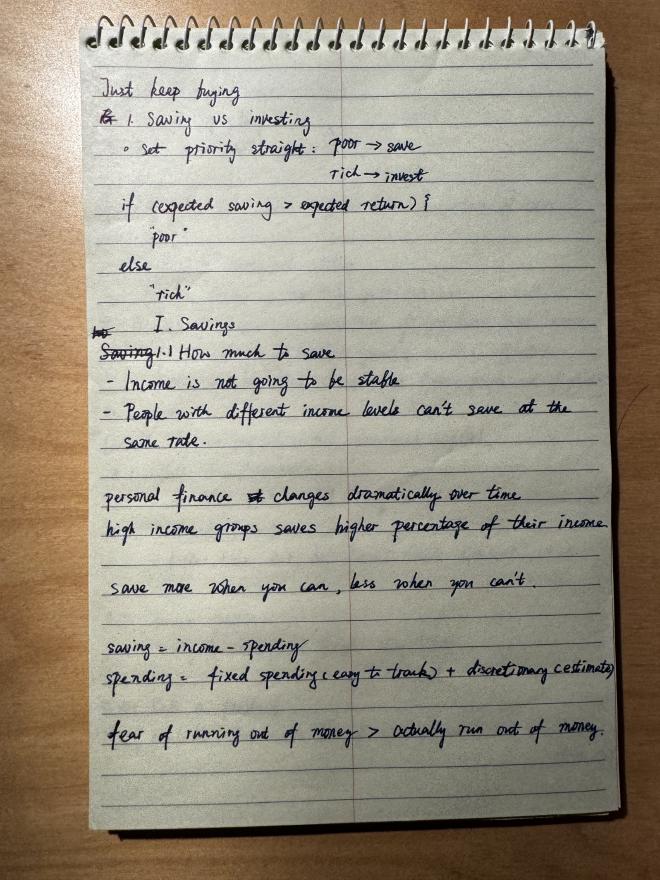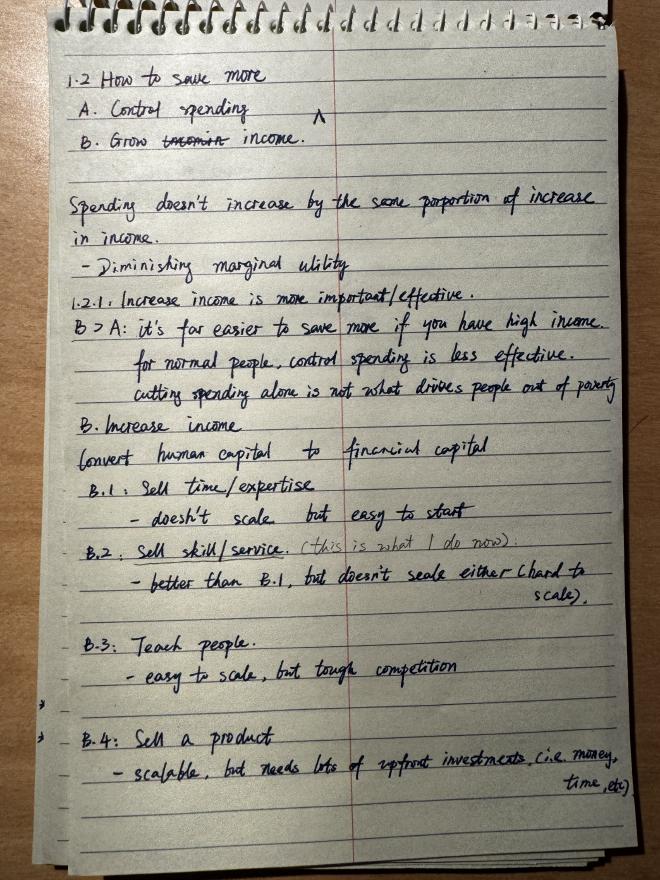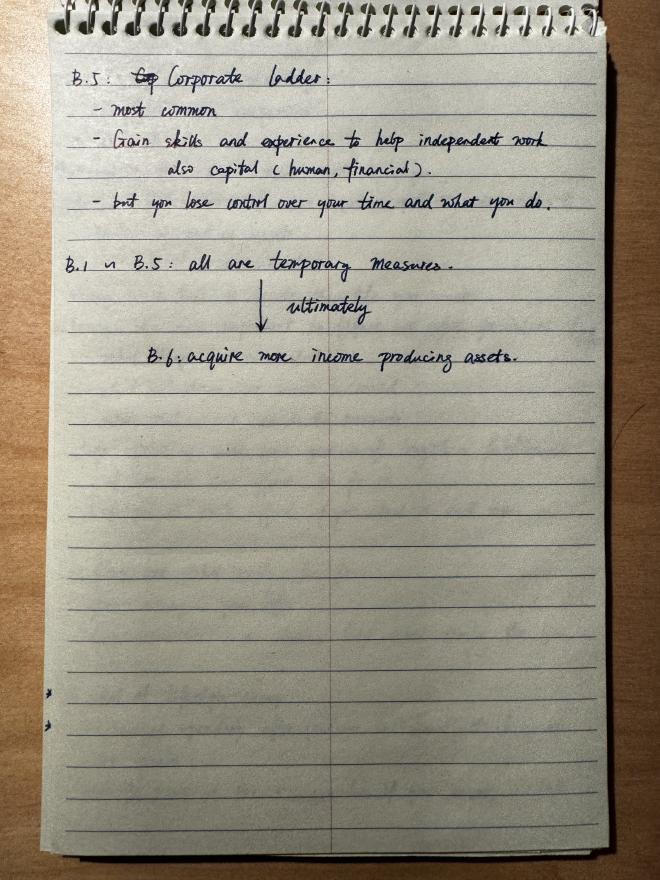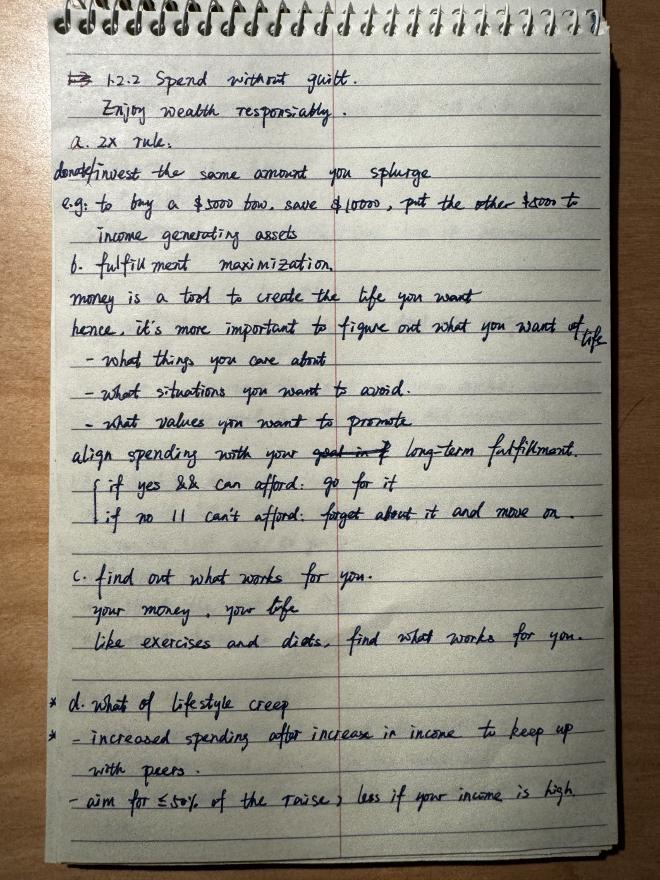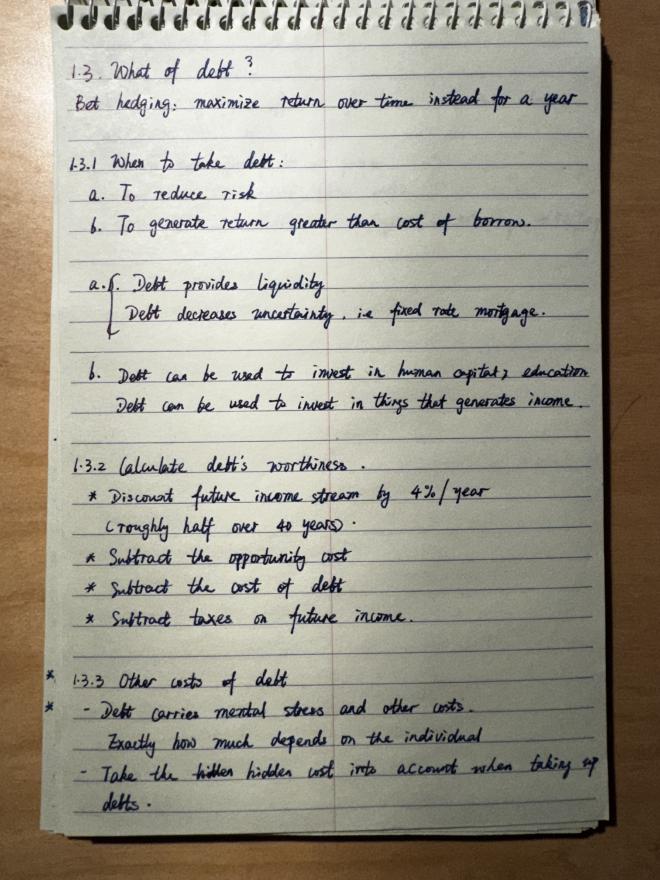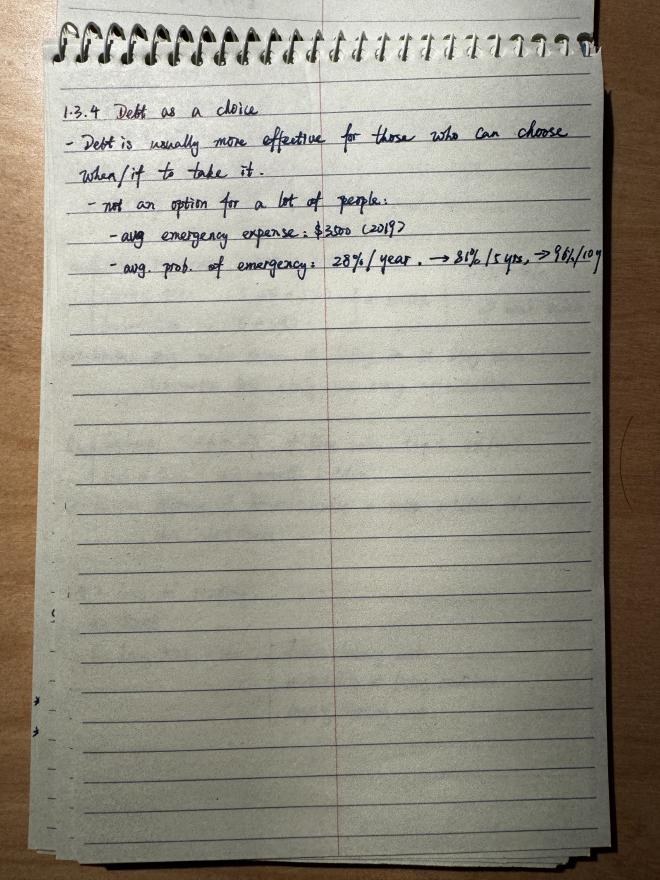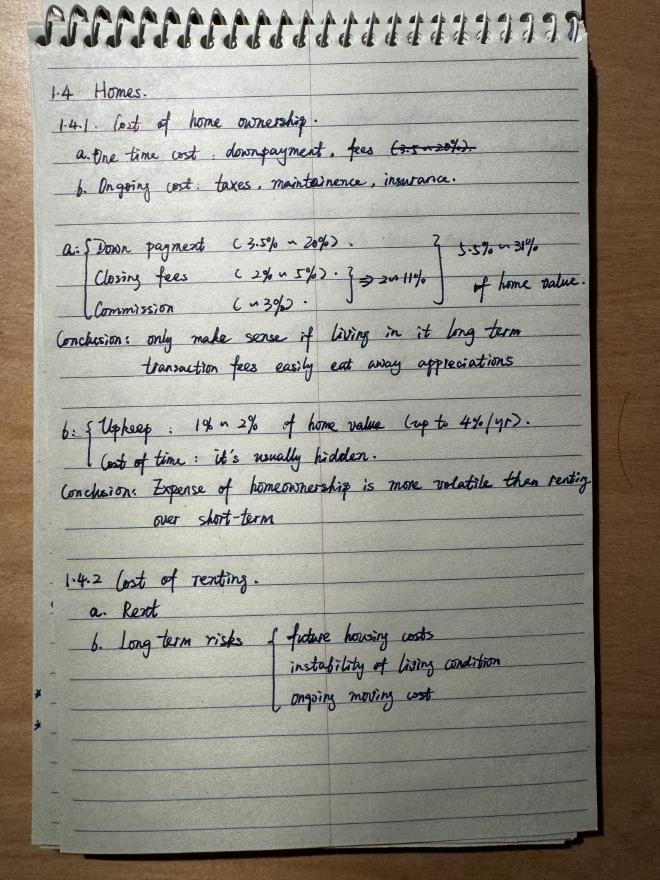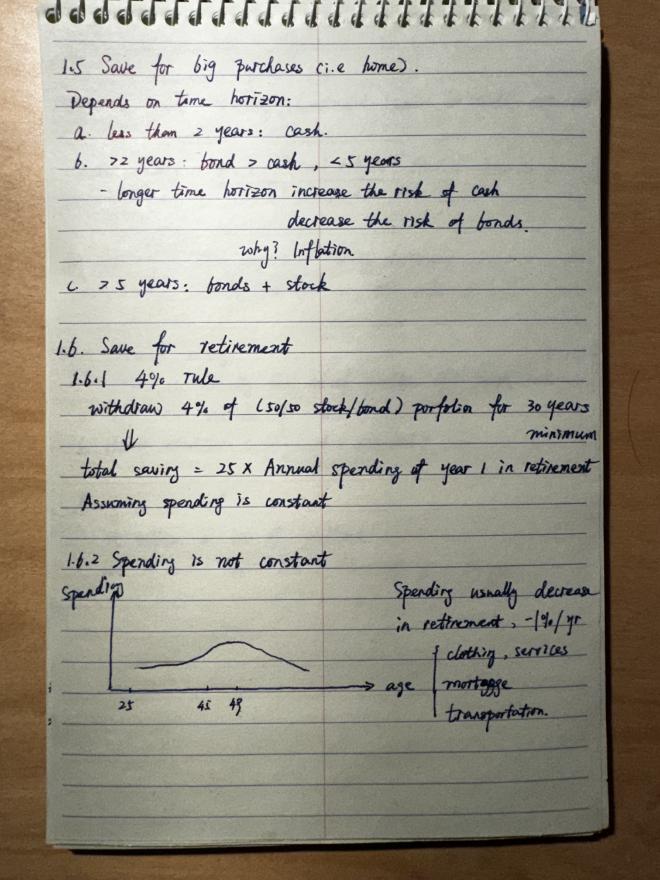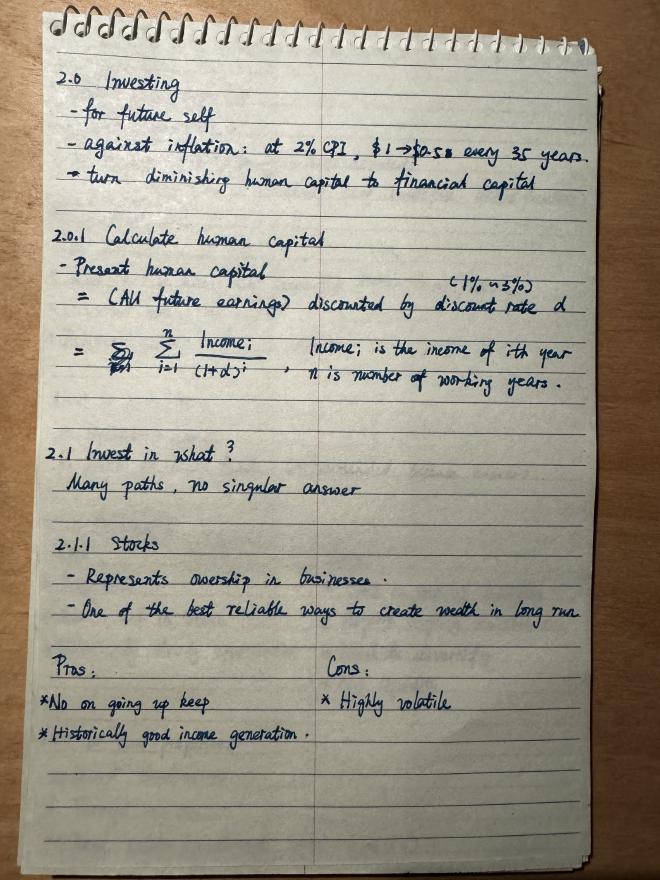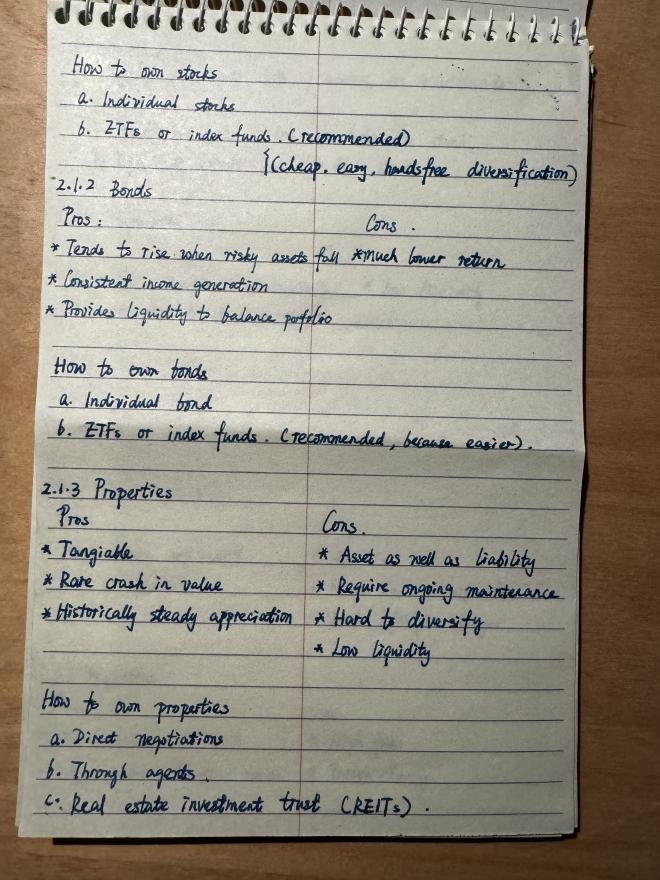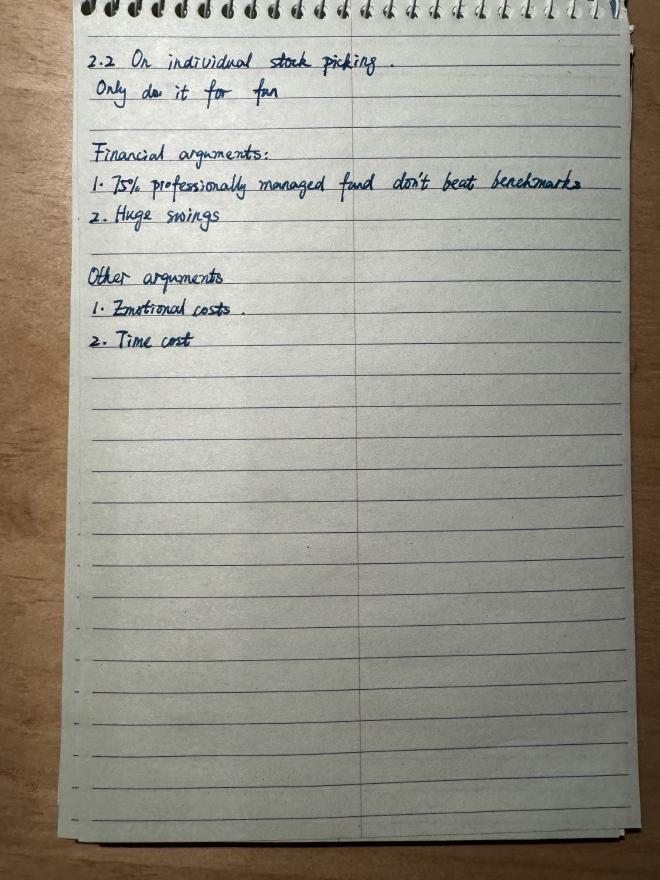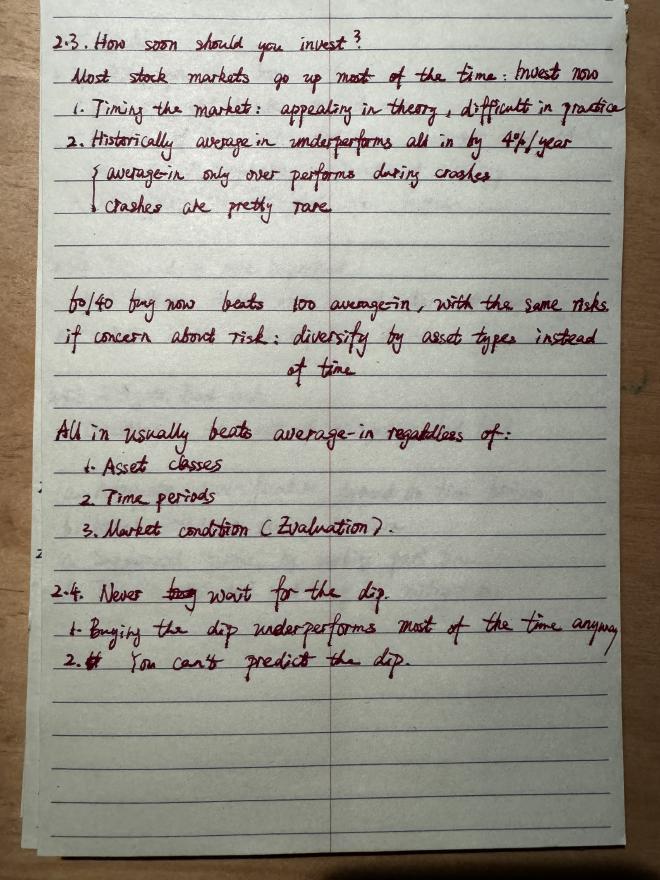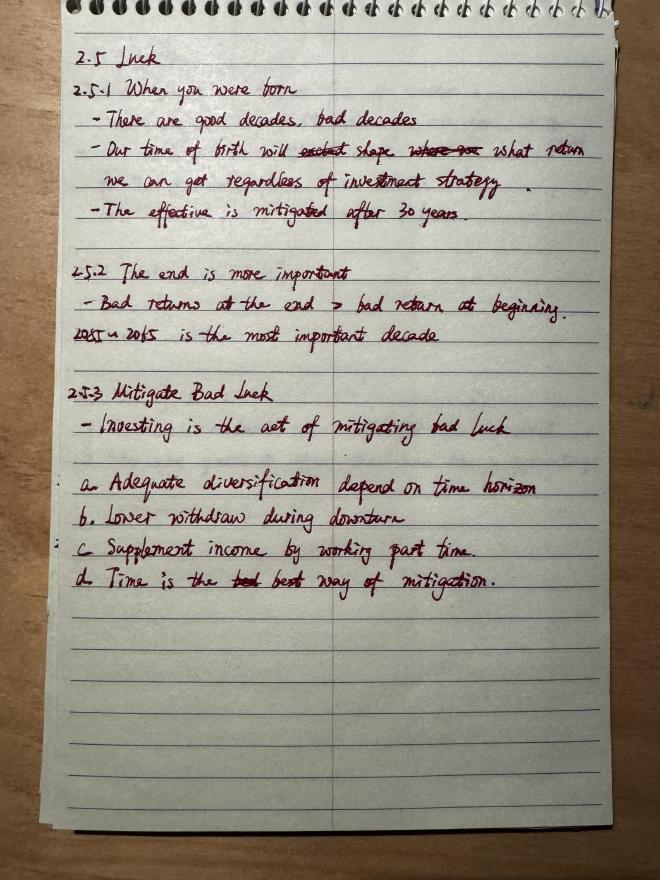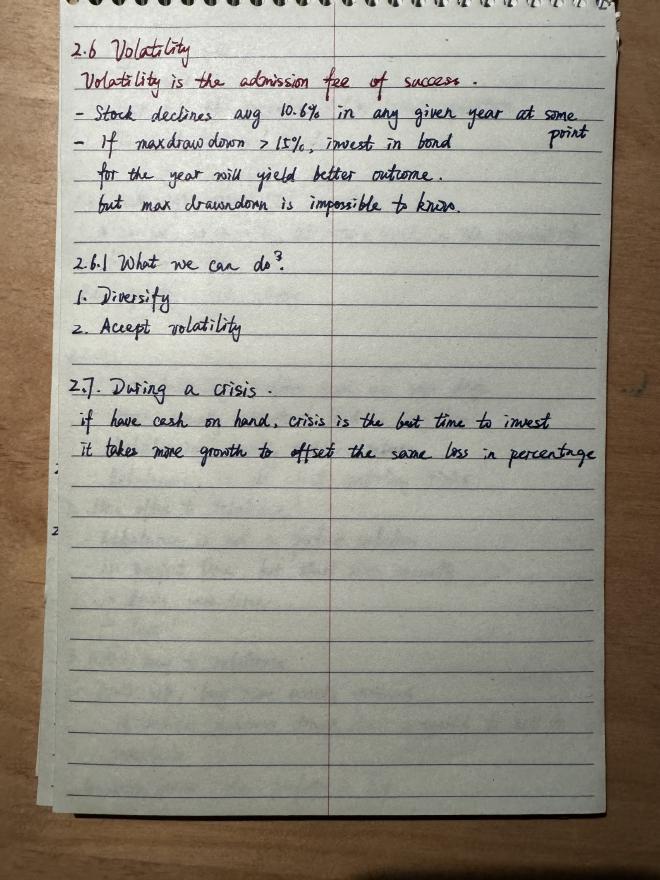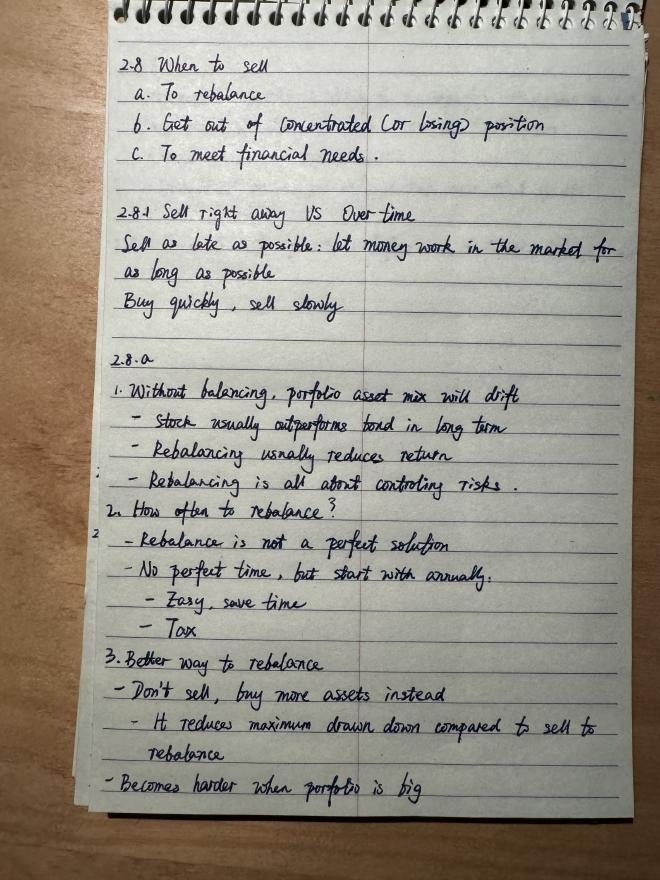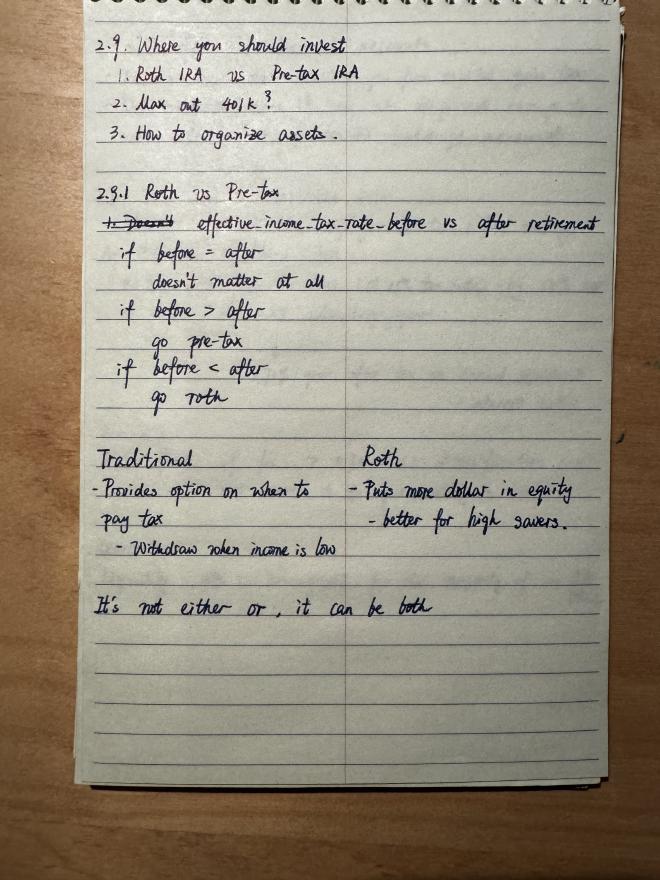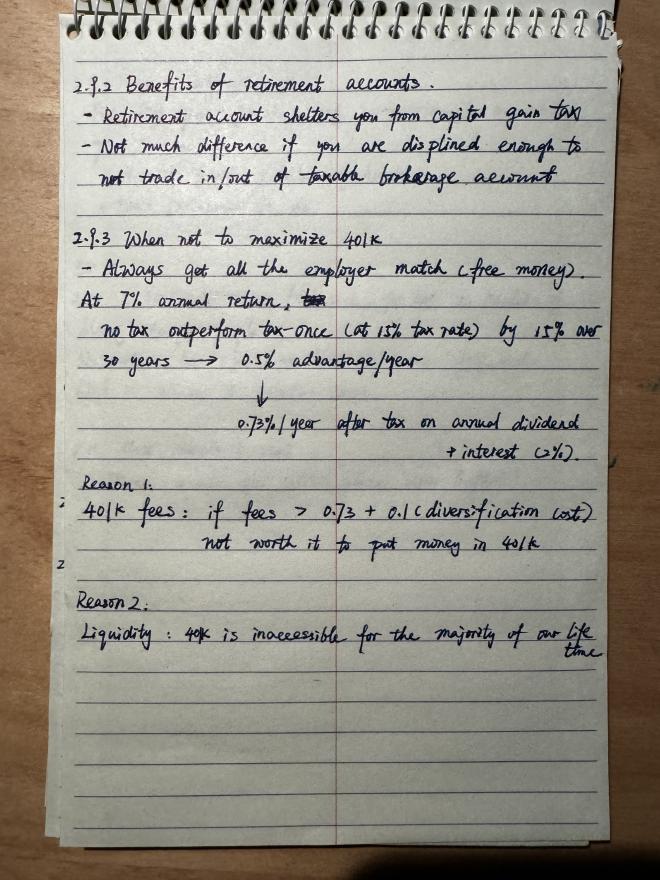Just Keep Buying
Read in December 2023 and January 2024
0. Savings and Investing #
expected saving= money you can easily save in a yearexpected return= money you expect to get from existing investment
if (expected_saving > expected_return)
You are 'poor', focus on saving more
else
You are 'rich', focus on investing
1. Saving #
1.1 How much to save? #
Save more when you can, less when you can’t
- Income won’t be stable over the lifetime
- People with different income levels can’t save at the same rate: high income usually translate to higher savings rate
1.2 How to save more? #
Since Saving = income - spending:
a. Control spending
b. Grow income
Control spending
- Spending usually don’t increase by the same proportion of increase in income: diminished marginal utility
- Cutting spending is rarely what drives people out of poverty
Grow income
- Usually more effective than control spendings
- It is easier to save more when income is higher
1.2.1 How to grow income? #
Income is grown by converting human capital into financial capital
- Sell time/expertise: easy to start, doesn’t scale
- Sell skill/service: better than 1, still hard to scale
- Teach: tough competition, easy to scale
- Sell a product: high initial investment, easy to scale
- Corporate laddering; most common, gain skills/experience in exchange of control over time and what to do
- Acquire more income producing assets: ultimate goal, 1 - 5 are all temporary in order to do 6
1.2.2 How to spending responsibly? #
Responsible spending brings contentment without guilt 1.2.2.1: 2X Rule:
- Invest the same amount we splurge in income producing asset 1.2.2.2: Fulfillment maximization:
- Money is a tool to create the life we want, spend on things that get us closer to what we want in life
- What things do you care about?
- What situations do you want to avoid?
- What values do you want to promote?
- Align spending with our long-term fulfillment:
if (algined AND canAfford) go for itif (notAligned OR cannotAfford) forget and move on1.2.2.3: Find what works for you
- It’s your money. Find what works for you personally 1.2.2.4: Lifestyle creep Increased spending after increase in income to keep up with peers
- Aim for
<= 50%of the raise, less if income is higher
1.3 What of debt? #
Debt is not always bad.
1.3.1 When to take debt? #
- To reduce risk: debt provides liquidity, decreases uncertainty
- To generate return higher than the cost of borrowing
1.3.2 Calculate debt’s worthiness #
- Discount future income stream as a result of debt by
4%/year(roughly 50% over 40 years) - Subtract opportunity cost
- Subtract cost of debt
- Subtract taxes
1.3.3 Other costs of debt #
- Stress and emotional cost: exactly how much depends on individual
1.3.3 Debt as a choice #
- Debt is usually more effective for those who can choose when/if to take it
- Not an option for many people
1.4 Home #
1.4.1 Cost of home ownership #
1.4.1.1 One time cost #
- Down payment:
3.5% - 20% - Closing fees:
2% - 5% - Commissions:
3%Total cost:5.5% - 31%of home value. It only makes sense if living in it long term. Transaction fees easily eats away appreciations.
1.4.1.2 Ongoing cost #
- Upkeep:
1% - 2% - Cost of time
Total cost:
~2%of home value per year. Expense of home ownership is more volatile than renting over the short term.
1.4.2 Cost of renting #
- Rent
- Long term risks
- Future housing costs
- Instability of living condition
- Ongoing moving cost
1.4.3 Home as investment #
- From 1915 - 2015, U.S homes appreciates
0.6%/yearafter adjusting for inflation - Opportunity cost of investing in home is usually far higher than its return over the long term: Home is not a incoming producing asset
- Home value is far less volatile than most other asset class
1.4.4 When to buy a home #
- Plan to live there for at least 10 years
- Stable professional and personal life
- Can afford it:
>= 20% down payment AND mortgage/income < 43%
1.5 How to saving for big purchases (e.g home) #
It depends on the time horizon: longer time horizon increases risks of cash, decreases risks of bond due to inflations
if (horizon <= 2 years)
Cash is king
else if (horizon > 2 years AND horizon < 5 years)
Bond over cash
else if (horizon > 5 years)
Consider a mix of bond + stock
1.6 Save for retirement #
1.6.1 The 4% Rule #
A point where you can withdraw 4% of a 50/50 stock/bond portfolio for at least 30 years: Total saving required = 25 x Annual spending of first year in retirement (if spending is constant)
1.6.2 Spending is not a constant #
- Data suggests spending usually decrease in retirement by about
1%/year- Lower needs for new clothing, services, transportations
- Mortgage is usually paid off
1.6.3 The cross over point rule #
A point where investment income > expense
- Total saving required = expense / return rate ~= 4% rule result
1.6.4 Retirement is more than just money #
- Finance is usually not the chief problem for retirees
- Fulfillment in retirement and health conditions (mental + physical) usually turn out to be the more important issues
- Money is a tool that solves a lot of problems, but it won’t solve the problem of your being
2. Investing #
- Investing is for our future selves
- Investing is a hedge against inflations: $1 deprecate by 50% over 35 years at 2% CPI
- Investing is turning diminishing human capital into financial capital
Human capital = All future earnings discounted by a discount rate (1-3%)
2.1 Invest in what? #
Many paths, no singular answer
2.1.1 Stocks #
- Represents ownership in businesses
- One of the best reliable ways to create wealth in the long term
Pros
- No ongoing up keeps
- Historically good income generation over the long term
Cons
- Highly volatile
How
- Buy individual stocks
- ETFs or index funds (recommended, cheap, easy, handsfree diversifications)
2.1.2 Bonds #
Pros
- Tends to rise when risky assets fall
- Consistent income generation
Cons
- Much lower return
How
- Buy individual bond
- ETFs or index funds (recommended, cheap, easy, handsfree diversifications)
2.1.3 Properties #
Pros
- Tangible
- Usually does not crash in value
- Historically steady appreciation
Cons
- It is an asset as well as a liability
- Require on going maintenance
- Hard to diversity
- Low liquidity
How
- Direct negotiations
- Through agents
2.1.4 Real estate invest trust (REIT) #
Pros
- Stock-like return
- Low correlation to stock
Cons
- Equal or greater volatility than stocks
2.1.5 Farmlands #
Pros
- Competitive compound return (7% - 9%) if well managed
- Low correlation to other assets
Cons
- Low liquidity
- Requires ongoing upkeep
How
- Direct buying
- Through REIT
2.1.6 Angel investing #
Pros
- High return (20% - 25%) Cons
- Most will lose
- Huge time commitment
- It’s more of a profession
2.1.7 Royalties #
Pros
- Steady income (5% - 20%)
- Low correlation to other assets
Cons
- High fees
- Tastes are hard to predict
How
- Buy individual stocks
- ETFs or index funds (recommended, cheap, easy, handsfree diversifications)
2.1.8 Your own products #
Books, services, information, etc
Pros
- Ownership
- Potentially high return
Cons
- Huge initial investment, no return guarantee
2.1.9 Gold, crypto, arts, etc #
- Values are based solely on perceptions
- Have no reliable income streams
- They are non-incoming generating assets
- Recommend make up < 10% of total investment portfolio
2.2 On buying individual stocks #
Only do it for fun. Put in what you are willing to lose Why?
- 75% professionally managed funds don’t beat market benchmark
- Insanely high volatility, emotional + time cost
2.3 How soon should you invest? #
Now: Most stock markets go up most of the time
2.3.1 Timing the market #
- Appealing in theory, difficult to practice
- Historically average-in underperforms all-in by 4%/year
- Average-in only over performs during crashes, crashes are pretty rare
- 60/40 all-in beats 100 average-in with the same risks: diversify by asset types instead of time
2.4 Never wait for the dip #
- Historically buying the dip under performs most of the time anyway
- You can’t predict the dip
2.5 Luck #
2.5.1 When you were born #
- There are good decades, there are bad decades
- Our birth time will shape what kind of return we can get regardless of investment strategy
- The act of investing itself is to mitigate against potential bad luck
2.5.2 The end is more important #
- Bad returns at the end of the time horizon is worse than bad returns at the beginning
- Personally 2055 - 2065 is the most important for me
2.5.3 Mitigate bad luck #
- Adequate diversification depending on time horizon
- Lower withdraw during downturn
- Supplement income by working part time
- Time is the best way of mitigating against bad luck
2.6 Volatility #
-
Volatilities are like ocean waves, you won’t get to the new world if you can’t stomach it.
-
Volatility is the admission fee of success
-
Stock will decline an average of 10.6% in any given year at some point
-
If max draw down > 15% for the year, it’s better to invest in bonds. But max draw down is impossible to know
2.6.1 What can we do? #
- Diversify
- Accept volatility
2.7 During a crisis #
If have investable cash on hand, crisis is the best time to invest. It takes more percentage growth to offset the same loss in dollar term.
2.8 When to sell #
a. To rebalance b. Get out of concentrated (or losing) positions c. To meet financial needs
2.8.1 Sell right away vs over time #
- Sell as late as possible: let money work in the market for as long as possible
- Buy quickly, sell slowly
2.8.a To rebalance #
Without rebalancing, portfolio asset mix will drift
- Usually stock outperforms bond in the long term
- Rebalancing usually reduces return but also reduces risks
How often to rebalance
- No perfect time, but start with annually: easy, save time, tax season
Better way to rebalance
- Don’t sell, buy more instead
- It reduces max drawn down compared to sell to rebalance
- Becomes harder when portfolio is large
2.8.b Get out of concentrated (or losing) positions #
- Concentrated positions is likely to underperform the market in the long term. Avg stock return 6.6% vs 9.9% of S.P500
- Don’t sell all at once (Tax!!)
- Sell based on a pre-defined rule and stick to it no matter what
2.8.c To meet financial needs #
Fund the life you need before risk it for the life you want
2.9 Where you should invest #
2.9.1 Roth vs pre-tax #
if tax_rate_before == tax_rate_after
does not matter at all
if tax_rate_before > tax_rate_after
go pre-tax
if tax_rate_before < tax_rate_after
go roth
if not sure
why not go both?
2.9.2 Benefits of retirement accounts #
- Shelters you from capital gain tax
- Not much difference to a taxable account if you are disciplined to not trade in/out frequently
2.9.3 When not to maximize 401k #
- Always get all your employer match, it’s free money
- If your 401k has high fees (>= 0.83%), the fee could offset all tax advantages
- 401k is effectively inaccessible for the majority of our life time
2.9.4 Asset organization #
- Theoretically: put high growth/risk assets in non-taxable account, low return/risk asset into taxable account
- It makes rebalancing harder
- Time consuming
- In reality, just forget it
2.10 Know you will never feel rich #
- Rich is a relative term
- No matter how rich you get, you will never feel you are rich
2.11 Most important asset is not money #
Time is the most important asset, would you switch places with Buffet right now?
3. Conclusions #
- ‘Poor’ should focus on saving, ‘rich’ should focus on investing
- Save what you can
- Have more income more effective than limit spending
- 2x rule for spending
- Save 50+% of raises and bonuses
- Debt is a tool, it’s not always bad
- Only buy a home when time is right (finance + lifestyle)
- Use cash to save for big purchases
- Retirement is more than money
- Investment = convert human capital to financial capital
- Buy incoming generating assets
- Don’t pick individual stocks
- Buy quickly, sell slowly
- Invest as often as you can
- Investing is an act against bad luck
- Volatility is the admission fee of playing the game
- Crashes are good opportunities to buy
- Money is a tool, use it to get the life you want to live
- Rethink about maximize 401k
- You’ll never feel you are rich enough
- Time is the single most valuable assets of all
